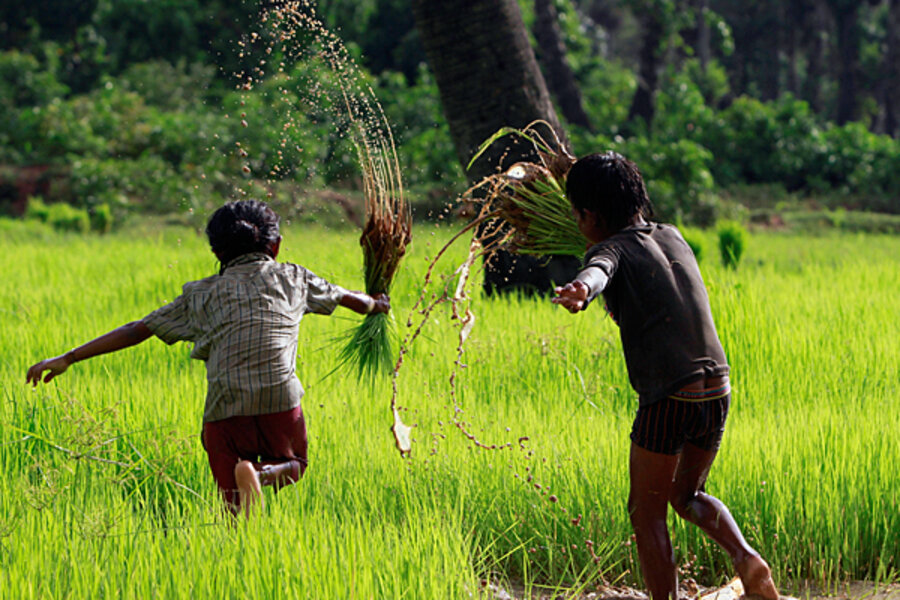Cambodia tests 'super rice' to fortify its children
Loading...
| KOMPONG SPEU, Cambodia
For breakfast, it’s rice. For lunch, it’s rice again, and for dinner – rice. Sometimes, Cambodian Un Koy says, her mother will prepare some beans or carrots, and on very special days even fish or pork.
Wearing a school uniform dotted with earthy stains, the 8-year-old runs across the school yard at her remote school, her black, sleek ponytail bounces as she keeps slipping out of her shoes. At first glance, Koy looks like most of her 70 classmates. But she has just failed a simple cognitive test and is about seven inches shorter than her peers – both because of malnutrition, a result of her simple rice diet, doctors say.
Across Asia, rice is the most widely consumed staple. That’s especially true in Cambodia, where it constitutes 70 percent of the rural population’s calorie intake. For Koy, the rice diet – low in zinc, iron, and vitamins B and D – has led to underdevelopment, say specialists. Health professionals say some 1 billion children suffer from similar malnourishment worldwide.
Now, a team of researchers from the Marseille-based Institute of Research for Development in Cambodia are close to bringing that number of malnourished children down by fortifying their staple diet with nutrients. The IRD team is currently evaluating a survey among 2,500 school children who participated in a pilot free meal project, substituting their World Food program free meal of rice, with fortified rice once a day on every school day for breakfast.
The stakes are high: If the pilot shows the expected results on learning capabilities and long-term development, IRD’s partners, health non-profit Path and the World Food Program (WFP), have vowed to use it as a model for developing countries across the world.
“Food insecurity has become much less of a problem in Southeast Asia in recent years. But the food people get is lacking quality. So they eat a lot of rice, which gives them energy, but no nutrients,” says senior IRD researcher Frank Wieringa, who leads the project.
This directly affects children's performance in school, according to “Food for Thought," a report released in April by nonprofit Save the Children. Globally, malnourished children score 7 percent lower in math tests and are 19 percent less likely to read at the age of 8. The long-term disadvantages for the children whose diet leaves them behind can be devastating, write the authors of the report.
"Children who are malnourished go on to earn 20 percent less as adults than the children who are well nourished," with some experts putting that figure as high as 66 percent, according to Save the Children.
As malnourished children perform poorly in school and drop out earlier, they decrease their country's gross domestic product by between 2 percent and 11 percent, which can translate to an impact on the global economy of up to $125 billion.
The process that could change this is straightforward and inexpensive, says Mr. Wieringa. "We take rice flour and add what we need – in principle you can add anything you like. And then the rice flour is pressed into normal-looking rice grains” and mixed with conventional rice.
As opposed to the controversial genetically modified (GMO) rice, fortified rice is not genetically modified at any time of the process. Normal rice flour is taken and mixed with selected vitamins and minerals, making it a process of adding, not engineering.
The fortified rice is then distributed through WFP’s school-meal program, which currently benefits more than 24 million children worldwide.
“The main aim of the school meals was to get kids to go to school and make sure they are not hungry, because that makes it difficult to study. But now, we have learned that it is a beautiful way to add essential vitamins and minerals to the diet of the children," says Wieringa.
That the survey shows an improvement in children’s nutritional state is a given, he says. "But I hope that we are able to show more; that we improve the functional outcome as well, like the ability to learn, an impact on their growth,” says Wieringa.
Currently, the WFP annually spends about $23 to feed one child one meal per day in a Cambodian school. By spending an extra $0.50 per year on each child, the organization could have a local factory produce and fortify that rice and have better results.
Similar projects are already being conducted in developing countries such as Egypt, Swaziland, and Burundi. And if the biological survey in Cambodia shows the expected results, more countries are likely to follow, says Nils Grede, former deputy chief of WFP’s nutrition and HIV policy department. WFP is discussing the potential of fortified rice with the governments of India and Indonesia.
“With close to 1.5 billion people and large public safety-net programs that give free or subsidized rice to the poor, these countries would be the real prize,” says Mr. Grede.







